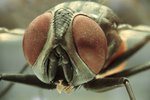
A guinea pig may be infested with dormant mites for years before he exhibits the symptomatic itching, skin sores and hair loss. Since mites may deposit their eggs underneath the skin's surface, it is important to quarantine new cavies you suspect may have been exposed to mites before introducing them to your healthy pets. Mites can be more than a mere nuisance--they can be deadly. Guard against mite infestation, and treat any suspected case promptly with aggressive measures.
Skin Mites

Sarcoptid, or "skin" mites are parasitic members of the arachnid family that feed on the skin, blood or fur of an animal. These microscopic creatures burrow beneath the skin to lay their eggs, which can remain dormant for years. Active skin mites may cause severe itching, skin sores, pain, dehydration or even death in a guinea pig. Though the mites are not transmittable to humans, they can easily migrate from pig to pig, and they may remain in your pet's bedding for up to three weeks, so it is important to to clean the cage on a regular basis.
Symptoms of a Mite Infestation

If your cavy is extremely itchy, or if he has developed bald patches or dry, scaly skin or oozing open sores, he may be suffering from an infestation of skin mites. Though fleas and lice are visible with the naked eye, microscopic skin mites live beneath the skin and are recognizable only by their associated symptoms. Take your guinea pig to the vet at the first sign of mites to avoid the progressive discomfort, disfigurement and danger of infestation. Left untreated, a mite infestation can eventually cause extreme pain, seizures and even complete baldness.
Diagnosis

Because many of the symptoms of mites in guinea pigs are similar to those of other parasitic skin disorders, such as fungi or ringworm, your veterinarian will mostly need to perform tests to make a firm diagnosis in your pet. First, he will take a skin scraping and examine it under a microscope to look for mites. A more definitive test, however, is a fungal culture of your pet's hair, since there may not always be enough mites present in a scraping to easily view under a microscope.
Treatment

The good news about a diagnosis of mites is that, once begun, treatment is usually quick and effective. Your veterinarian will probably prescribe multiple doses of oral, topical or injected ivermectin to alleviate your guinea pig's mite condition. Since the medication will not kill mite eggs or larvae, you will need to re-medicate at intervals (usually 2-3 doses, given 10 days apart) to ensure the mite infestation is completely gone. If you have more than one Guinea Pig, you should treat all of them to address any cross-infestation, even in the absence of symptoms. Clean any shared space thoroughly with non-toxic disinfectant and water, then replace the bedding.
References
- A Guinea Pig may be infested with dormant mites for years before he exhibits the symptomatic itching, skin sores and hair loss.
- Because many of the symptoms of mites in Guinea Pigs are similar to those of other parasitic skin disorders, such as fungi or ringworm, your veterinarian will mostly need to perform tests to make a firm diagnosis in your pet.
- Your veterinarian will probably prescribe multiple doses of oral, topical or injected ivermectin to alleviate your Guinea Pig's mite condition.
Resources
Photo Credits
-
Jupiterimages/Photos.com/Getty Images




